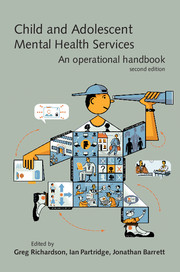Book contents
- Frontmatter
- Contents
- Tables, boxes and figures
- Contributors
- Abbreviations
- Preface
- 1 Introduction
- 2 CAMHS in context
- 3 CAMHS and the law
- 4 Structure, organisation and management of CAMHS
- 5 Evidence-based practice
- 6 Clinical governance
- 7 Education, supervision and workforce development
- 8 Multidisciplinary working
- 9 User and carer participation and advocacy
- 10 A comprehensive CAMHS
- 11 Referral management
- 12 Demand and capacity management
- 13 Strategies for working with Tier 1
- 14 Structuring and managing treatment options
- 15 CAMHS in the emergency department
- 16 Paediatric liaison
- 17 Self-harm
- 18 Learning disability services
- 19 Services for autism-spectrum disorders
- 20 Attentional problems services
- 21 Eating disorder teams
- 22 Bereavement services
- 23 CAMHS for refugees and recent immigrants
- 24 CAMHS and looked-after children
- 25 Drug and alcohol teams
- 26 Parenting risk assessment service
- 27 Court work
- 28 Tier 4 options
- 29 In-patient psychiatric care
- 30 Forensic services
- 31 Neuropsychiatry and neuropsychology services
- 32 Mental health provision for deaf children: study of a low-incidence service provision
- 33 Chief Executives – what do they want and how do they get it?
- Index
17 - Self-harm
Published online by Cambridge University Press: 02 January 2018
- Frontmatter
- Contents
- Tables, boxes and figures
- Contributors
- Abbreviations
- Preface
- 1 Introduction
- 2 CAMHS in context
- 3 CAMHS and the law
- 4 Structure, organisation and management of CAMHS
- 5 Evidence-based practice
- 6 Clinical governance
- 7 Education, supervision and workforce development
- 8 Multidisciplinary working
- 9 User and carer participation and advocacy
- 10 A comprehensive CAMHS
- 11 Referral management
- 12 Demand and capacity management
- 13 Strategies for working with Tier 1
- 14 Structuring and managing treatment options
- 15 CAMHS in the emergency department
- 16 Paediatric liaison
- 17 Self-harm
- 18 Learning disability services
- 19 Services for autism-spectrum disorders
- 20 Attentional problems services
- 21 Eating disorder teams
- 22 Bereavement services
- 23 CAMHS for refugees and recent immigrants
- 24 CAMHS and looked-after children
- 25 Drug and alcohol teams
- 26 Parenting risk assessment service
- 27 Court work
- 28 Tier 4 options
- 29 In-patient psychiatric care
- 30 Forensic services
- 31 Neuropsychiatry and neuropsychology services
- 32 Mental health provision for deaf children: study of a low-incidence service provision
- 33 Chief Executives – what do they want and how do they get it?
- Index
Summary
‘It isn't as if there was anything wonderful about my little corner. Of course for people who like cold, wet, ugly bits it is something rather special, but otherwise it's just a corner.’
A. A. Milne, The House at Pooh CornerIntroduction
Suicide has long been recognised as a societal phenomenon as well as an individual one (Durkheim, 1970) and national strategies have been developed to address this (Department of Health, 2002).
Approximately 7–14% of adolescents harm themselves at some point; 20% will think seriously about it (Madge et al,2008; O'Connor et al2009), representing a considerable workload for CAMHS, both numerically and in terms of the risk posed and anxiety generated, and it is recognised that many such young people do not even reach the attention of health services (Hawton & Rodham, 2006). The most common forms of self-harm are cutting, scoring, scratching, overdosing and less commonly burning or punching. Most young people describe that they self-harm to forget about stress, relieve anxiety and, less commonly, to kill themselves (Young et al, 2007).
Most are not suffering from mental illness, although it is the responsibility of CAMHS to assess and treat these young people, as well as the anxiety engendered in others. Around 0.5–1% of young people who present following an episode of self-harm complete suicide, and 40% of those who survive a first attempt will repeat it; CAMHS should aim to reduce these figures.
Such young people may be referred to a CAMHS at a number of points in the cycle of self-harm (Box 17.1). Clinical and epidemiological information is readily available to inform practice in the management of self-harm (Rutter, 1990; Kerfoot et al,1996; Meltzer et al,2001; Wood et al,2001; Gould et al,2003; Fox & Hawton, 2004).
Providing a service
The assessment of the young person who has primarily self-harmed should be regarded as part of the everyday work of CAMHS. A speedy response can help alleviate anxieties. Competence, calmness and clarity of thinking is more important than the professional background of the assessor.
- Type
- Chapter
- Information
- Child and Adolescent Mental Health ServicesAn Operational Handbook, pp. 162 - 168Publisher: Royal College of PsychiatristsPrint publication year: 2010



